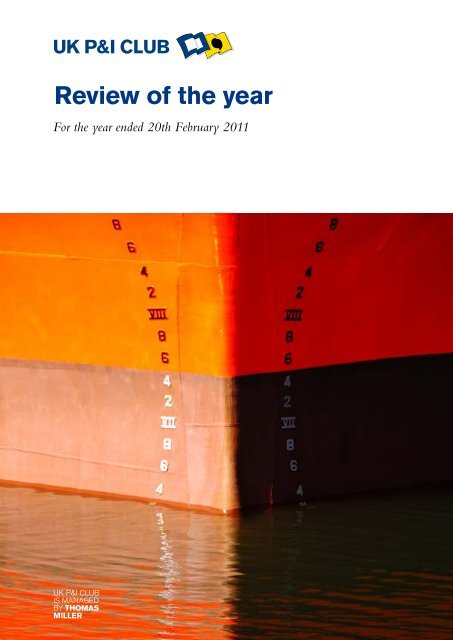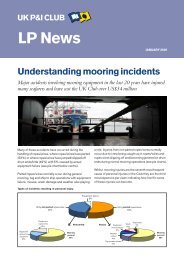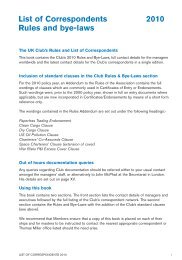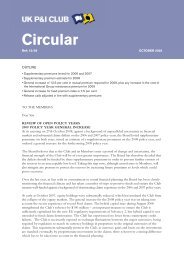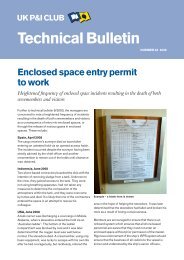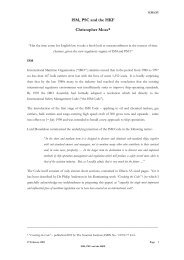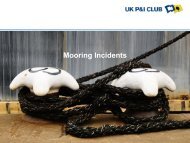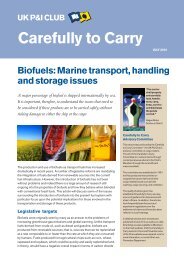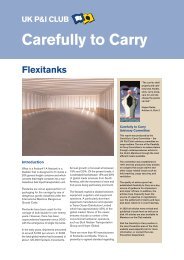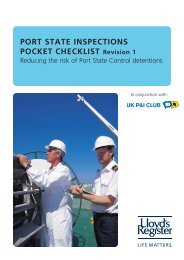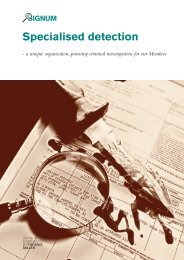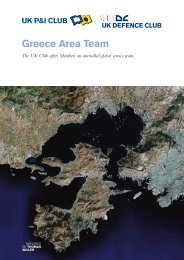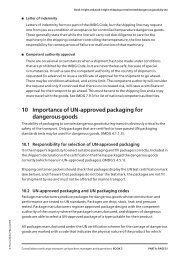2011 ROTY - UK P&I
2011 ROTY - UK P&I
2011 ROTY - UK P&I
Create successful ePaper yourself
Turn your PDF publications into a flip-book with our unique Google optimized e-Paper software.
Review of the year<br />
For the year ended 20th February <strong>2011</strong>
FINANCIAL HIGHLIGHTS<br />
FINANCIAL STRENGTH<br />
CLAIMS POSITION<br />
• Capital and reserves<br />
increased to $478 million<br />
• Capital and reserves<br />
per ton increased to $4.5<br />
• Standard and Poor’s rating of A- (Stable)<br />
• Capital adequacy per the S&P capital<br />
model comfortably in the AA range<br />
• Total assets $1.6 billion<br />
• 2010 policy year performing<br />
broadly in line with 2009<br />
• Prudent approach to reserving maintained<br />
particularly on the 2010 policy year<br />
• 2009 encouraging development<br />
within prudent reserve set last year<br />
• Frequency of claims remains low<br />
• Loss record within the Pool maintained<br />
so reducing future pooling percentages<br />
Capital and reserves<br />
for financial years 2006 –<strong>2011</strong><br />
Net notified claims<br />
at 12 months for policy years 2001–2010<br />
500<br />
5<br />
250<br />
400<br />
4<br />
200<br />
300<br />
3<br />
150<br />
$m<br />
$<br />
$m<br />
200<br />
2<br />
100<br />
100<br />
1<br />
50<br />
0<br />
2005/6 2006/7 2007/8 2008/9 2009/10 2010/11<br />
0<br />
0<br />
2001 2002 2003 2004 2005 2006 2007 2008 2009 2010<br />
Free reserves<br />
Hybrid capital<br />
Reserves / Ton (right axis)<br />
Cargo Cruise curtailment FCOO<br />
Illness Injury Charterers Pool<br />
140%<br />
120%<br />
100%<br />
80%<br />
60%<br />
40%<br />
20%<br />
UNDERWRITING DISCIPLINE<br />
• Combined ratio of 98%<br />
beats target of 100%<br />
• 65% of all entered vessels<br />
below 10 years of age<br />
• Discipline maintained on entry criteria<br />
with quotes refused on 5 million GT<br />
• 25 new Members in the year<br />
Combined ratio for financial years<br />
2006 –<strong>2011</strong><br />
2005/6 2006/7 2007/8 2008/9 2009/10 2010/11<br />
$ m<br />
100<br />
80<br />
60<br />
40<br />
20<br />
0<br />
-20<br />
-40<br />
-60<br />
-80<br />
INVESTMENT PERFORMANCE<br />
• Return of 6.16% for the year,<br />
versus a benchmark 5.97%.<br />
• Strong returns from each asset class —<br />
equities, bonds and absolute return funds<br />
• Portfolio positioned<br />
conservatively for the future<br />
Financial year<br />
investment performance<br />
2005/6 2006/7 2007/8 2008/9 2009/10 2010/11<br />
12%<br />
10%<br />
8%<br />
6%<br />
4%<br />
2%<br />
0%<br />
-2%<br />
-4%<br />
-6%<br />
-8%<br />
Reported<br />
combined ratio<br />
Excluding<br />
supplementary calls<br />
Target<br />
$ return % return
CAPITAL & RESERVES Year ending Year ending Year ending<br />
Amounts in $m 20/2/<strong>2011</strong> 20/2/2010 20/2/2009<br />
Total funds & capital 1,287.0 1,207.0 1,141.0<br />
Outstanding claims 808.7 797.7 807.5<br />
Free reserves & capital 477.9 409.3 333.7<br />
Free reserves & capital<br />
ratio to outstanding claims 159 % 151 % 141 %<br />
Portfolio composition<br />
21%<br />
17%<br />
26%<br />
15%<br />
Equities<br />
8%<br />
Cash<br />
9%<br />
Absolute Return Funds<br />
54%<br />
50%<br />
Fixed Interest<br />
Feb <strong>2011</strong> Feb 2010<br />
INCOME & EXPENDITURE<br />
INCOME Year ending Year ending<br />
Amounts in $m 20/2/<strong>2011</strong> 20/2/2010<br />
Calls and premiums 364.8 447.2<br />
Reinsurance premiums ( 70.2 ) ( 75.9 )<br />
294.6 371.3<br />
EXPENDITURE<br />
Net claims incurred ( 250.4 ) ( 320.0 )<br />
Acquisition costs ( 20.3 ) ( 23.1 )<br />
Net operating expenses ( 20.4 ) ( 21.0 )<br />
( 291.1 ) ( 364.1 )<br />
Operating surplus 3.5 7.2<br />
Investment return 69.5 78.7<br />
Interest payable on hybrid capital ( 9.0 ) ( 9.0 )<br />
Surplus before taxation 64.0 76.9<br />
Taxation ( 1.4 ) ( 1.7 )<br />
Surplus after taxation 62.6 75.2
CHAIRMAN’S STATEMENT<br />
“<br />
I am again pleased to report another<br />
operating surplus for the year just ended<br />
and a further significant increase in<br />
the Club’s free reserves and capital<br />
which now stand at $478 million, the<br />
highest they have ever been. Holding<br />
capital at this level puts us in a strong<br />
position to meet the challenging<br />
requirements of the new European<br />
solvency regime which will take effect<br />
from 2013. Just as importantly, our<br />
Members can be confident that the<br />
process of rebuilding the Club’s reserves<br />
has been successful and that the Club is<br />
now back in a position of considerable<br />
financial strength from which to<br />
meet the challenges of the future.<br />
It is an extremely encouraging sign<br />
of that confidence that during the last<br />
year the Club saw some 15 million gt<br />
of newly acquired tonnage join the<br />
Club, mainly from our existing<br />
Members, even though this was offset<br />
to a much greater extent than normal<br />
by the effect of sales and scrapping.<br />
Investment income has again made<br />
a welcome contribution this year, of<br />
nearly $70 million, to the surplus. This<br />
represents a return of 6.2 per cent,<br />
significantly higher than the 5 per cent<br />
long term average return we have been<br />
targeting. Our investment policy is kept<br />
under regular review and the board of<br />
our subsidiary reinsurance company,<br />
IPIR, monitors closely the performance<br />
of the investment managers within the<br />
policy set by the board to reflect the risk<br />
appetite we have agreed for the Club.<br />
In addition to the investment income,<br />
the Club recorded a small operating<br />
surplus which brings our combined ratio<br />
below 100 per cent. This means that in<br />
this financial year we have achieved our<br />
goal of balanced underwriting so that<br />
all the investment income of the year<br />
is effectively transferred to the reserves<br />
rather than being required to support<br />
an underwriting deficit. It is important<br />
that we continue to aim for a combined<br />
ratio of 100 per cent or lower, since<br />
we have seen in the past how quickly<br />
reserves can be reduced by successive<br />
underwriting deficits, even when<br />
starting at an apparently healthy level.<br />
At our meeting in October last year,<br />
when the Directors reviewed the half<br />
year position, the Board decided to<br />
impose a general increase of 5 per<br />
cent for <strong>2011</strong>, which we considered<br />
to be prudent in the context of the<br />
expected inflationary impact on<br />
claims. In itself the increase will<br />
not ensure an underwriting surplus<br />
since next year’s result will inevitably<br />
depend on how claims develop, but<br />
it was designed to help premium<br />
levels at least keep pace with the<br />
anticipated effect of claims inflation.<br />
The level of claims is always difficult<br />
to assess accurately even once a policy<br />
year has ended, but as we had expected,<br />
the 2009 policy year claims picture has<br />
developed favourably and continues to<br />
improve. More encouragingly, the 2010<br />
year at this early stage is not showing<br />
signs of a significant increase in claims<br />
although in line with our usual policy<br />
on reserving, we have set a conservative<br />
claims reserve for the year to reflect the<br />
relative uncertainty of the outcome.<br />
Looking forward, it is of course<br />
not possible to predict the level of<br />
claims we will experience in <strong>2011</strong>.<br />
As mentioned however, the effect of<br />
the general increase should give some<br />
protection against inflationary factors<br />
and we have again put in place the<br />
reinsurance protection for our own<br />
claims to which I referred last year.<br />
This reinsurance programme safeguards<br />
the Club against a significant uplift<br />
in claims within the Club’s own $8<br />
million retention under the Group<br />
pooling arrangements, as well as giving<br />
additional protection against claims<br />
at the Pool level and furthermore<br />
protects us against a single very large<br />
loss from one of our own Members.<br />
free reserves<br />
and capital,<br />
which now<br />
stand at<br />
$478 million,<br />
are the highest<br />
they have<br />
ever been<br />
we have<br />
achieved our<br />
goal of balanced<br />
underwriting<br />
4
Clearly these financial developments<br />
and the current strength of our capital<br />
position will be important as we<br />
move to comply with the developing<br />
requirements of the European Solvency<br />
2 regime; but as I mentioned last year,<br />
the new regulatory regime also places<br />
great importance on a company’s<br />
corporate governance arrangements and<br />
its ability to assess and manage risk.<br />
As Solvency 2 approaches, we have<br />
initiated a high level review of our<br />
structure with a view to optimising<br />
the amount of capital required. At<br />
the same time, the opportunity will<br />
be taken to simplify and streamline,<br />
where appropriate, the corporate<br />
governance arrangements for the<br />
Club, whilst still maintaining the<br />
benefits of a widely representative<br />
board drawn from the membership<br />
and the technical expertise of our<br />
independent professional managers.<br />
This active membership participation<br />
in the governance of the Club reflects<br />
the mutual nature of the Club which<br />
is shared with the other clubs in the<br />
International Group and lies at the<br />
heart of the pooling and reinsurance<br />
arrangements of the Group. Ultimately<br />
these are designed to provide all<br />
Members with the highest sustainable<br />
level of cover at an economic cost.<br />
In August last year the European<br />
Commission initiated a formal<br />
investigation into the competition<br />
aspects of these arrangements<br />
following on from the expiry of the<br />
second ten year exemption for the<br />
International Group Agreement. We,<br />
and all other clubs in the International<br />
Group, are fully co-operating with<br />
this investigation and have been<br />
providing full and timely answers to the<br />
Commission’s requests for information.<br />
We hope that as on the previous<br />
occasions when the Commission has<br />
considered these matters in detail, the<br />
conclusion will be that the Group’s<br />
pooling and reinsurance arrangements<br />
remain appropriate. These arrangements<br />
provide unique benefits in the high<br />
levels of cover made available at<br />
economic cost, delivering security<br />
not only to the members of all the<br />
clubs (who are the consumers in<br />
this context), but also to the wider<br />
public in the context of the major<br />
human, environmental or property<br />
claims that occur from time to time.<br />
During the year, the Board also had<br />
to consider the serious implications<br />
for the Club of recent sanctions<br />
legislation in Europe and the United<br />
States, particularly in relation to<br />
Iran. The apparently growing trend<br />
towards including insurance in<br />
international trade sanctions has<br />
raised new issues for the Club.<br />
There is a difficult balance to be<br />
struck between trying to ensure that<br />
individual Members have the best<br />
possible cover for their own legitimate<br />
trading operations and protecting<br />
the Club and all its Members from<br />
the serious consequences of being in<br />
breach of relevant sanctions legislation.<br />
As a result of the Board’s consideration<br />
of this issue, Rule changes have<br />
been introduced for the <strong>2011</strong> policy<br />
year which we hope reflect a fair<br />
solution and will give the Club<br />
the essential protection we felt<br />
was necessary. Unfortunately one<br />
casualty was the enforced departure<br />
from the Club of a long-standing<br />
Member for whose fleet the Club<br />
was no longer able safely to provide<br />
cover as a result of such legislation.<br />
Whatever the outcome of the review I<br />
referred to earlier, it is certain that the<br />
workload of Directors, and particularly<br />
the members of two of the Board’s<br />
key committees—the Strategy and<br />
the Audit & Risk committees—will<br />
not be reduced. We are very conscious<br />
the process<br />
of rebuilding<br />
the Club’s<br />
reserves has<br />
been successful<br />
5
of our responsibilities not only as a<br />
result of the regulatory requirements<br />
but also of our responsibility to the<br />
membership. Inevitably, increasing<br />
time has to be devoted to ensuring a<br />
full understanding of the risks faced by<br />
the Club, the effective management of<br />
those risks and the implementation of<br />
the Board’s policies by our Managers.<br />
At the same time we are also a Board<br />
which is concerned with general<br />
industry-wide issues faced by our<br />
membership. Often these are reflected in<br />
the claims reports which the Managers<br />
provide for us at each of our meetings<br />
but even where we are less directly<br />
concerned with claims, we monitor<br />
developments closely with a view to<br />
trying to provide as much support and<br />
guidance for our Members as we can.<br />
This is reflected in the high volume of<br />
loss prevention and advisory material<br />
which our Managers are providing<br />
on a weekly basis through the Club<br />
web site which has become such an<br />
important feature of the Club’s service.<br />
We have been most concerned for<br />
example, by the predicament of those<br />
seafarers caught up in piracy. Detailed<br />
reports from the Managers, and<br />
contributions from individual Directors<br />
with expertise in countering piracy, have<br />
helped the Board to monitor activities<br />
at a political, military and industry level,<br />
and to promote Members’ awareness of<br />
the crucial role of industry self-defence<br />
through the Best Management Practices.<br />
The work of the main committees of the<br />
Board has become ever more demanding<br />
as we seek to ensure with the Managers<br />
that the Board has the necessary<br />
information and, where appropriate,<br />
recommendations to discharge its<br />
responsibilities. We rely heavily on<br />
the members of these committees<br />
and I am most grateful to them all for<br />
giving their time and experience so<br />
generously. I am particularly indebted<br />
to the deputy chairmen—Eric André,<br />
who is Chairman of both IPIR and<br />
the Audit & Risk committee, Alan<br />
Olivier who represents the Club on<br />
the Thomas Miller Board and Patrick<br />
Decavèle for their guidance and<br />
support as well as the long hours they<br />
devote as members of virtually all<br />
the committees. It is thus with great<br />
sadness that we have said farewell<br />
to Patrick who has served the Board<br />
and the Club with great distinction.<br />
Two other directors who have<br />
also given the Club distinguished<br />
service retired last October—Sergey<br />
Frank and John Ioannidis—and I<br />
would like to thank them for their<br />
contributions particularly in John’s<br />
case where over the last fifteen years<br />
his commitment and service to the<br />
Club have been exemplary. I would<br />
also like to make special mention<br />
of Jan Kopernicki who retired from<br />
Shell in March of this year, having<br />
been a director of the Club for over<br />
twelve years; his eloquence and clarity<br />
of thought will be greatly missed.<br />
Finally I would like to take this<br />
opportunity to thank our Managers<br />
for the work they do on behalf of the<br />
Club. For all Members, the Managers<br />
represent the face of the Club in their<br />
day to day dealings with underwriters,<br />
claims executives, loss prevention<br />
experts or just on general enquiries.<br />
The Managers’ team has been led in<br />
recent years by Luke Readman who has<br />
announced his intention to retire this<br />
year after nearly 40 years of working<br />
for Thomas Miller. We will miss his<br />
understated style of leadership and the<br />
benefits of intellect and experience he<br />
has brought to our Board meetings, but I<br />
have every confidence that his successor<br />
Hugo Wynn Williams, ably supported<br />
by Nigel Carden, will now take the<br />
Club forward from the sound financial<br />
base we have re-established successfully<br />
to meet the challenges that lie ahead.<br />
Dino Caroussis, Chairman<br />
the Club is now<br />
back in a position<br />
of considerable<br />
financial<br />
strength from<br />
which to meet<br />
the challenges<br />
of the future<br />
“<br />
6
PERFORMANCE<br />
FOR THE YEAR TO FEBRUARY <strong>2011</strong><br />
This year has seen the Club build on the<br />
success of last year and deliver a surplus<br />
after taxation of $63 million, raising the<br />
free reserves and capital to $478 million.<br />
A key feature of this year’s surplus was the<br />
achievement of a combined ratio of 98 per<br />
cent, reflecting improved underwriting<br />
discipline while maintaining a prudent<br />
approach to claims reserving.<br />
The Club now has $1.6 billion in total<br />
assets and with a free reserve ratio (asset<br />
to liability) of 159 per cent is one of the<br />
strongest clubs in the International Group.<br />
The excellent underwriting result has<br />
been supported by an investment return<br />
of 6.2 per cent, which outperformed the<br />
benchmark portfolio whilst balancing<br />
the risk of the various asset types in what<br />
is still an uncertain investment market<br />
for both fixed interest and equities.<br />
The Club has successfully rebuilt<br />
its capital position through careful<br />
management and continues to<br />
deliver the highest quality of service<br />
to Members in what have been<br />
volatile and challenging times.<br />
UNDERWRITING<br />
The Club experienced a favourable<br />
underwriting year, seeing improved<br />
loss ratios, a reduction in the average<br />
age of the entered fleet and sustained<br />
levels of owned and chartered entries.<br />
The Club was able to welcome<br />
more than 25 new Members.<br />
World ship building activity remains<br />
above historical averages despite the<br />
delays to many scheduled delivery<br />
dates. Scrapping and sales levels have<br />
been equally elevated and the Club<br />
experienced nearly 20 per cent fleet<br />
turnover when assessing the combined<br />
40%<br />
35%<br />
30%<br />
25%<br />
20%<br />
15%<br />
10%<br />
5%<br />
impact of sales, scrapping and additional<br />
new buildings entered. The high level of<br />
underwriting activity has the favourable<br />
result of improving the age profile of<br />
the entered fleet but, unsurprisingly,<br />
newer ships will tend to come on<br />
risk at lower rates than older ships.<br />
The table below sets out the average<br />
age profile of the entered owned fleet<br />
immediately after the 20th February<br />
<strong>2011</strong> renewal. A third of ships entered<br />
in the Club are below five years of age,<br />
with roughly 65 per cent of all owned<br />
ships in the Club below ten years of age.<br />
Table 1: Age profile of Club owned entered tonnage as of 20 th February <strong>2011</strong><br />
0–4 years<br />
5–9 years<br />
10–14 years<br />
15–19 years<br />
20–25 years<br />
Over 25 years<br />
7
The fleet profile by trade type is<br />
set out in Table 2. The Club entry<br />
profile broadly reflects the world<br />
fleet, though the Club has slightly<br />
higher relative entries of some trade<br />
types such as tankers and gas vessels.<br />
Table 2: <strong>UK</strong> Club owned tonnage profile at 20th February <strong>2011</strong> by trade type<br />
Tanker 29%<br />
Bulk Carrier 33%<br />
Passenger 3%<br />
Container 15%<br />
Car Carrier / RoRo 2%<br />
Gas Carrier 12%<br />
Other 6%<br />
At the <strong>2011</strong> renewal, 14 per cent of the<br />
Club’s Members changed deductible<br />
terms, slightly less than the 20 per cent<br />
the year before. As inflation continues<br />
for most types of claim, in particular<br />
routine crew claims, the Club<br />
continues to encourage Members to<br />
review deductible levels. Appropriate<br />
deductible levels are important for<br />
the results of Members and for the<br />
Club as a whole, and the Board will<br />
once again review standard levels<br />
of deductibles in October <strong>2011</strong>.<br />
During the year the Club continued to<br />
stress the importance of the quality of<br />
the membership. Ship inspections took<br />
place on 350 vessels and the inspectors<br />
endeavour to work cooperatively with<br />
Members to identify best practices and<br />
share the Club’s loss prevention experience.<br />
Importantly, the Club maintains cautious<br />
policies when considering new owners<br />
for entry in the Club. During the year,<br />
the Club declined to offer quotes for<br />
more than 5 million gt which did not<br />
meet the Club’s underwriting standards.<br />
8
CHARTERER’S BUSINESS<br />
On average the Club had in excess of<br />
80 million gt of chartered business on<br />
risk at any one time during 2010. The<br />
overall premium derived from the<br />
charterers’ book of business has remained<br />
between $45–50 million per policy year<br />
between 2008 and 2010 and did not<br />
suffer a meaningful decline in activity<br />
as shipping rates slumped and global<br />
chartering activity slowed. Momentum<br />
was maintained through a combination<br />
of new charterer Members and a better<br />
than expected level of chartering<br />
activity from existing Members. The<br />
charterers’ book of business is now<br />
an important part of the Club’s<br />
CLAIMS<br />
The 2010 financial year has seen<br />
a continuation in the positive trend<br />
in the claims development on the<br />
overall activity and makes a positive<br />
contribution to the financial results.<br />
Broker relations remain important<br />
to the Club, with more than half the<br />
Members of the Club entered through<br />
an intermediary. The Club seeks to<br />
work closely with intermediaries in<br />
all aspects of the underwriting process<br />
and sharing of information about the<br />
Club. The Club hosted a series of<br />
broker receptions and financial briefings<br />
during the year, and continued to<br />
improve the online resources available<br />
to both Members and brokers.<br />
more recent policy years,<br />
particularly 2009, as can be<br />
seen clearly in the table below.<br />
Table 3: Net notified claims for policy years 2001–2010 at February <strong>2011</strong><br />
350<br />
Notified claims ($m)<br />
300<br />
250<br />
200<br />
150<br />
2010<br />
2009<br />
2008<br />
2007<br />
2006<br />
2005<br />
2004<br />
2002<br />
2001<br />
2003<br />
100<br />
50<br />
0<br />
0 4 8 12 16<br />
Quarter<br />
20 24 28 32<br />
9
There is now strong evidence of a link<br />
between the performance of the shipping<br />
markets and the volume of P&I claims,<br />
particularly the attritional or lower<br />
level claims. Although there are some<br />
tentative signs of recovery in parts of<br />
the world economy, many sectors of the<br />
shipping market remain in the doldrums<br />
and this is likely to continue for at least<br />
the next 12 months. The outlook for<br />
attritional claims is therefore likely to<br />
be benign in the near future. The larger<br />
claims, those in excess of $500,000,<br />
are more random in nature and do not<br />
necessarily follow the same pattern.<br />
The table below shows the best estimate<br />
of the ultimate claims by policy year<br />
along with the cost of the Pool as a<br />
proportion of the total claims. The main<br />
change during the financial year to 20th<br />
February <strong>2011</strong> has been the positive<br />
development in the claims on the 2008<br />
and 2009 policy years and the consequent<br />
reduction in the ultimate claims provision<br />
on those years. The 2010 policy year<br />
is at a very early stage of development<br />
and even though the year is showing<br />
a similar development to that of 2009<br />
policy year the claims ultimate is higher<br />
reflecting the inherent uncertainty in<br />
forecasting claims after only 12 months<br />
development. It is expected that 2010 is<br />
likely to deliver a similarly encouraging<br />
underwriting result as 2009 once the year<br />
has developed for a further 12 months.<br />
Table 4: Ultimate claims (best estimate) for policy years 2001–2010 at February <strong>2011</strong><br />
350<br />
35%<br />
300<br />
30%<br />
Ultimate claims ($m)<br />
250<br />
200<br />
150<br />
100<br />
25%<br />
20%<br />
15%<br />
10%<br />
50<br />
5%<br />
0<br />
2001 2002 2003 2004 2005 2006 2007 2008 2009 2010<br />
0<br />
Non Pool<br />
Pool<br />
% of Pool total<br />
10
POOL<br />
Pool claims for the 2010 policy year are<br />
at a similar level to those of 2009 (see<br />
Table 5), and it is encouraging that the<br />
Pool has not returned to the claims<br />
levels reached on the 2006 and 2007<br />
policy years. Nonetheless, the Club<br />
has purchased additional reinsurance<br />
protection for Pool claims for both the<br />
2009 and 2010 policy years which will<br />
provide a cap on the Club’s exposure<br />
to any deterioration should there be<br />
any late development on these years.<br />
Table 5: Net notified Pool claims for policy years 2001–2010<br />
100<br />
90<br />
80<br />
2006<br />
Notified Pool claims ($m)<br />
70<br />
60<br />
50<br />
40<br />
30<br />
20<br />
10<br />
2010<br />
2009<br />
2008<br />
2007<br />
2005<br />
2004<br />
2002<br />
2003<br />
2001<br />
0<br />
0 4 8 12 16<br />
Quarter<br />
20 24 28 32<br />
RETAINED CLAIMS<br />
The decline in the volume of world trade<br />
in 2009 and 2010 has had a beneficial<br />
impact on the number of claims reported.<br />
An example of this can be found in the<br />
drop in the frequency of claims in more<br />
recent policy years. The number of claims<br />
reported in the 2009 policy year was 25<br />
per cent lower than the claims reported<br />
for 2007. In addition to the impact of the<br />
downturn in the world economy, advances<br />
in technology and improvement in<br />
shipboard practices have also contributed<br />
to the improved claims position. However,<br />
the rise in the average value of claims<br />
reported last year has continued unabated.<br />
In 2000, the average claim cost was<br />
$17,806. By 2010, this figure had reached<br />
$29,069. Looking at particular claim<br />
types, the average cost of injury claims<br />
has risen from $6,996 in 2000 to $40,771<br />
in 2010. In 2000, collision claims cost<br />
on average $41,066. By 2010 that figure<br />
was $287,914. Whilst the latter category<br />
of claim is far more prone to volatility,<br />
the evidence clearly suggests that the<br />
cost of dealing with marine accidents is<br />
increasing. An understanding of these<br />
claims trends has enabled the Club to<br />
improve its underwriting results and to<br />
tailor its own reinsurance programme.<br />
11
LOSS PREVENTION<br />
As important as responding to Members’<br />
claims is the Club’s capacity to avoid<br />
losses. The shipment of iron ore<br />
fines and nickel ore from India and<br />
Indonesia respectively has presented<br />
unique challenges in that regard.<br />
The past two years have seen a number<br />
of instances where these cargoes have<br />
been loaded onto ships with a moisture<br />
content that exceeds the limit that is safe<br />
for carriage at sea. Following departure<br />
from the load port, these cargoes have<br />
been prone to liquefaction, which can<br />
seriously compromise a ship’s stability. At<br />
least 4 ships are reported to have capsized<br />
within the last year whilst carrying<br />
nickel ore cargoes, with a loss of 48<br />
lives. There have also been a number of<br />
“near misses” with iron ore fines loaded<br />
in India following on from two well<br />
documented losses in previous years.<br />
The Club has assumed a leading role<br />
in investigating these incidents and<br />
implementing measures which can be<br />
taken to reduce the risk of dangerous<br />
cargoes being loaded. These include<br />
detailed guidance for owners on the<br />
enquiries that should be made into<br />
these cargoes prior to shipment, and<br />
procedures for sampling and testing<br />
cargoes. These measures have not<br />
always been welcomed by the shippers<br />
of the cargoes who have frequently<br />
sought to circumvent the proper testing<br />
procedures. However, the inescapable<br />
fact is that no ships have been lost where<br />
these procedures have been followed.<br />
JAPANESE EARTHQUAKE<br />
AND TSUNAMI<br />
Shipping is an unpredictable business<br />
operating in a volatile world. No greater<br />
demonstration of unpredictability<br />
came with the Japanese earthquake<br />
and tsunami. The impact of these<br />
tragic circumstances on the Club<br />
will in all likelihood be minor,<br />
with property insurers bearing the<br />
majority of the losses involved.<br />
INDUSTRY MATTERS<br />
In August, the European Commission<br />
announced a formal investigation into<br />
certain aspects of the Group’s claims<br />
sharing and reinsurance arrangements,<br />
focussing on release call practices, the<br />
quotation procedures under the IGA,<br />
and access to reinsurance facilities<br />
provided by the commercial markets.<br />
A position paper has been used to<br />
assist Members in understanding the<br />
background, the issues raised and the<br />
IG’s response. Commission requests<br />
for information have provided a<br />
useful opportunity to substantiate<br />
theory with empirical data. It remains<br />
to be seen whether the concerns of<br />
the Commission can be alleviated,<br />
but in the meantime shipowners’<br />
organisations have expressed their own<br />
concerns that the benefits of the Group<br />
arrangements should not be jeopardised.<br />
Directors highly value the international<br />
nature of the Club and its Board, and the<br />
opportunities provided thereby to discuss<br />
shipping matters without regard to the<br />
divisions of politics. The ban under the<br />
EC Sanctions Regulations on provision<br />
of insurance to Iranian entities—even<br />
where engaged entirely in legal trades—<br />
brought an untimely end to a relationship<br />
with a longstanding Member and was<br />
much regretted. Sanctions regimes are<br />
blunt tools and it was necessary to make<br />
a number of Rule changes to protect the<br />
Club from the sanctions risks that could<br />
arise from activities of Members, or from<br />
gaps in Pooling or reinsurance coverage.<br />
Meanwhile, the problems of piracy have<br />
remained a constant theme for Board<br />
attention. A number of entered ships<br />
were hijacked and in some cases were<br />
used by pirates as mother ships, as pirate<br />
tactics evolved to overcome limitations<br />
of poor weather and to extend their<br />
range of attacks to areas distant from<br />
naval forces. Although claims on the<br />
Club have been largely restricted to<br />
crew injury and, fortunately, for the<br />
most part have not been serious, the<br />
risks to crew have grown substantially<br />
12
with longer hijack periods and increased<br />
use of violence to overcome defences.<br />
The Club’s website is regularly updated<br />
with piracy related information and the<br />
Managers have strongly recommended<br />
that owners take care to follow the<br />
industry Best Management Practices<br />
when sailing in the high risk area—<br />
which now extends almost to the shores<br />
of India. The need for self-defence has<br />
never been higher and a number of<br />
Members with ships having low speeds<br />
or low freeboards have assessed the risks<br />
as justifying the use of armed guards.<br />
Armed protection could eventually have<br />
its own dangers, especially if pirates<br />
counter stronger defences with stronger<br />
attacks. The Club recognises that there<br />
is a role for the use of private guards or<br />
(preferably) vessel protection detachments<br />
from navies in appropriate cases, but<br />
would remind Members that it is not<br />
a substitute for the basic anti-piracy<br />
measures recommended in the BMP.<br />
RISK & CAPITAL MANAGEMENT<br />
Risk and capital management have<br />
become an important focus of regulators<br />
and rating agencies alike in recent<br />
years. The Club has taken the issue<br />
of risk management seriously for<br />
some time within its Loss Prevention<br />
and Ship Inspection activities which<br />
represents the customer facing element<br />
of its risk management function. The<br />
development of the Individual Capital<br />
Assessment (ICA) regime by the <strong>UK</strong><br />
Financial Services Authority, over five<br />
years ago, led to the Club improving its<br />
management of risk across the business<br />
and using the ICA model to inform<br />
decisions in areas such as investment<br />
policy and reinsurance purchase. Whilst<br />
the techniques are becoming increasingly<br />
more sophisticated the underlying<br />
rationale remains the same, to manage<br />
risk and capital effectively for the benefit<br />
of Members, given the requirements<br />
of regulators and rating agencies.<br />
Central to managing risk across the<br />
business remains the quantitative and<br />
qualitative assessment of risk, which is<br />
focused on the Club’s internal risk model<br />
and the S&P rating model. Both of these<br />
models have been used for making key<br />
business decisions. The Club has now<br />
entered the Solvency 2 Internal Model<br />
Approval Process, which is the means<br />
by which the regulator will approve<br />
the Club’s approach to measuring its<br />
own Solvency Capital Requirement<br />
(SCR) under Solvency 2. The further<br />
development of the Club’s own risk<br />
model to meet these more exacting<br />
requirements will be taking place during<br />
<strong>2011</strong>. In addition to focusing on the<br />
Club’s insurance risks, the model will<br />
also provide a framework for one of the<br />
most important activities of an insurer,<br />
namely Asset-Liability Management,<br />
ALM. ALM ensures that an insurer<br />
matches the risk profile of the assets (the<br />
investment portfolio) with its liabilities,<br />
thereby protecting the capital base<br />
against an adverse change in claims,<br />
investments or currencies. ALM alone<br />
cannot protect an insurer against all<br />
risks. In its Corporate Plan, the Club<br />
considers not only the strategic direction<br />
of the Club, but also through thorough<br />
risk analysis the Plan identifies scenarios<br />
or extreme events that could seriously<br />
affect the Club’s financial position.<br />
The Club then considers the best way<br />
to mitigate these risks, some of which<br />
can be transferred through reinsurance,<br />
others through organisational processes<br />
and contingency plans. Finally, risks<br />
are also mitigated through holding a<br />
certain level of capital to meet solvency<br />
and regulatory requirements. Meeting<br />
regulatory capital standards is a minimum<br />
obligation, but the Club chooses to<br />
target a higher level of capital adequacy,<br />
13
the AA range on S&P’s capital model.<br />
In addition to building the Internal<br />
Model, the Club has undertaken detailed<br />
work with an independent firm of<br />
actuaries to develop its underwriting<br />
pricing, which complements the<br />
technical loss prevention activities.<br />
Risk and capital management is not solely<br />
about statistical analysis and complex<br />
modelling. It also relies on a robust<br />
governance framework and high quality<br />
management information on which<br />
to base decisions and prepare detailed<br />
analysis. The Report of Directors in the<br />
full Report & Accounts highlights some<br />
of the higher level changes to the Club’s<br />
governance during the year including<br />
the extension of the remit of the Audit<br />
INVESTMENTS<br />
REVIEW OF THE YEAR<br />
During the financial year economies<br />
and financial markets continued to<br />
recover from the financial crisis of 2008<br />
and 2009. The effects of that period<br />
on the developed economies remained<br />
evident, however. High levels of<br />
unemployment, large government budget<br />
deficits, and low levels of inflation and<br />
interest rates persisted. Central banks<br />
and governments typically pursued<br />
pro-growth anti‐deflationary policies<br />
in an effort to replace private sector<br />
lending which continued to decline as<br />
banks attempted to repair their balance<br />
sheets. The developing economies of<br />
Asia and Latin America, on the other<br />
hand, recovered more quickly from<br />
the (mostly Western) financial crisis<br />
and their authorities began to tighten<br />
policies to rein in growth and dampen<br />
increasing inflationary pressures.<br />
There were a number of economic events<br />
during the year which caused uncertainty<br />
and volatility in financial markets. These<br />
included civil unrest in North Africa, the<br />
rise in both hard and soft commodity<br />
Committee to cover risk matters in<br />
addition to its audit responsibilities. The<br />
Club has ensured that it has augmented<br />
the breadth and depth of experience of<br />
its Board members with experts in the<br />
fields of investment, reinsurance, finance,<br />
accounting and insurance matters. In<br />
addition, the Managers continue to<br />
strengthen their governance structure<br />
to be able not only to run the Club<br />
operations on a day to day basis, but also<br />
support the Board in their deliberations<br />
on risk and capital matters. The Club<br />
works closely with industry experts in<br />
the actuarial and investment fields and<br />
also participates in industry forums both<br />
inside and outside of the P&I sector to<br />
ensure that it is following best practice<br />
in what is still an emerging area.<br />
prices and the prospect of sovereign<br />
default in Europe. To date the effect of<br />
each of these has not been lasting but<br />
could, if they got worse, have quite an<br />
impact on financial markets in the future.<br />
PERFORMANCE<br />
The investment portfolio returned<br />
6.2 per cent during the year, adding<br />
$69.5 million to the Club’s assets. This<br />
performance outstripped the benchmark<br />
performance agreed with the Board.<br />
Within the portfolio the fixed interest and<br />
absolute return fund elements performed<br />
well against their respective benchmarks,<br />
with equities lagging slightly.<br />
There were no significant changes to<br />
the portfolio weightings during the<br />
year. The main theme was to reduce the<br />
level of cash given its low returns but<br />
not to increase the risk of the portfolio<br />
significantly. This was done with the<br />
selective purchases of corporate bonds<br />
and an increased equity weighting,<br />
mostly by way of exchange traded funds.<br />
14
SERVICE<br />
The <strong>UK</strong> Club aspires to the highest<br />
standards of service in all that it does.<br />
Service is provided by the Managers’<br />
worldwide network of offices located<br />
in London, Piraeus, Hong Kong,<br />
Singapore, Beijing, Shanghai, San<br />
Francisco and New Jersey. Service to<br />
Members is currently provided under<br />
established global systems and processes.<br />
These systems and processes continue to<br />
be certified under the ISO 9001:2000<br />
regime which is the standard published<br />
by the International Organisation<br />
for Standardisation in relation to<br />
quality management systems. The<br />
continuing achievement of this standard<br />
demonstrates the ongoing commitment<br />
to the highest levels of service.<br />
Service is often a distinguishing feature<br />
of the mutual insurance sector, and the<br />
Club is acutely aware that Members<br />
expect and deserve prompt, helpful<br />
responses whenever they contact the<br />
Club. Accordingly, the Club will<br />
conduct a Member Survey during<br />
the course of the forthcoming year<br />
in order to provide Members with<br />
the opportunity to comment upon<br />
the performance of the Club, and to<br />
make suggestions or recommendations<br />
for the future. Hearing the views<br />
and requirements of Members is of<br />
paramount importance to ensure that<br />
the Club continues to react to the needs<br />
of Members in a style and manner that<br />
provides real value and benefit. The<br />
results of the Survey will become<br />
available before the end of <strong>2011</strong> and<br />
will be made available to Members.<br />
During the year the Club re-developed<br />
its website. The breadth and scope of<br />
available information remains similar,<br />
but a more powerful search engine will<br />
improve access to that information. The<br />
Members Area and ClaimsTrac services<br />
have retained the same structure and<br />
operation enabling all information<br />
and records to be quickly and easily<br />
retrieved. The website continues to<br />
provide advice and guidance on the<br />
issues affecting the industry, contact<br />
details and information on the Managers’<br />
staff and the Correspondents’ network,<br />
and also information on the ships<br />
entered with the Club. It has, for<br />
some time, been recognised as one<br />
of the best websites in the industry<br />
and, with the recent redevelopment,<br />
this status has now been formally<br />
recognised with the award of “Best<br />
in Class” in the Insurance category<br />
at the Interactive Media Awards.<br />
A further development during the year<br />
was the completion of the work to<br />
update the Managers’ underwriting<br />
system. The new system has been<br />
developed over a period of about<br />
two years and will see a much<br />
improved underwriting platform that<br />
is more flexible, is based on modern<br />
underwriting methodologies and<br />
which has been developed using the<br />
latest IT infrastructure and advances.<br />
The Club has continued to support<br />
Members with technical presentations,<br />
seminars and specific events which are<br />
often targeted on the needs of particular<br />
groups from within the membership.<br />
An example of this is the annual Bodily<br />
Injury Team Seminar in the United<br />
States that focuses on these particularly<br />
expensive claims. Events are usually run<br />
by Club staff and often take place in a<br />
Member’s office or location. In addition,<br />
the Club seeks to provide education to<br />
Members through regular newsletters,<br />
contact with staff, and weekly email<br />
updates. Lastly, the Managers run an<br />
annual training event titled “An Insight<br />
into Transport Law and Insurance” to<br />
give Members an understanding of the<br />
issues and factors affecting the world<br />
in which the Club operates. This year’s<br />
course will take place in September<br />
<strong>2011</strong>, and a regional version will take<br />
place in Athens in December <strong>2011</strong>.<br />
15
Thomas Miller P&I Ltd<br />
London<br />
Tel: +44 20 7283 4646<br />
Fax: +44 20 7283 5614<br />
Thomas Miller (Hellas) Ltd<br />
Piraeus<br />
Tel: +30 210 42 91 200<br />
Fax: +30 210 42 91 207/8<br />
Thomas Miller (Americas) Inc<br />
New Jersey<br />
Tel: +1 201 557 7300<br />
Fax: +1 201 946 0167<br />
Thomas Miller (Hong Kong) Ltd<br />
Hong Kong<br />
Tel: + 852 2832 9301<br />
Fax: + 852 2574 5025<br />
www.ukpandi.com


